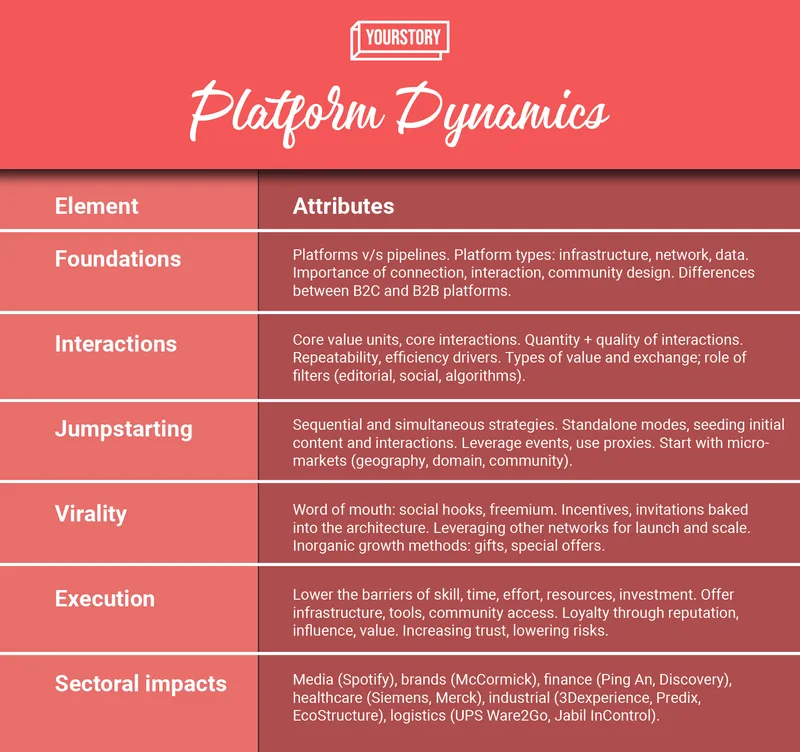Platform strategy: how to design interaction, value and trust for business success
This must-read book provides a wealth of frameworks, examples and tips of the platform business model. Here are some key insights and recommendations.
Launched in 2012, YourStory's Book Review section features over 315 titles on creativity, innovation, entrepreneurship, and digital transformation. See also our related columns The Turning Point, Techie Tuesdays, and Storybites.
Big tech firms and scale-stage startups are unleashing new value streams by leveraging digital platforms, according to the book Platform Scale for a Post-Pandemic World by Sangeet Paul Choudary.
See our picks of ‘Top 10 Books of the Year for Entrepreneurs’ from the past ten years: 2021, 2020, 2019, 2018, 2017, 2016, 2015, 2014, 2013, and 2012.
New disruptive opportunities lie not just in creating hardware or software, but in enabling social and business interaction via platforms. The pandemic has accelerated the rise of platforms in domains like retail and education, while also raising concerns over data access, privacy, usage, and concentration of power, the author explains.
Sangeet Paul Choudary is an innovation consultant and author, and co-chair of the MIT Platform Strategy Summit. His earlier books are Platform Revolution and Platform Scale.
Here are my key takeaways from the wide-ranging 320-page book, summarised as well in the table below. See also my reviews of the related books Future Tech, Innovation Ultimatum, Seeing Digital, Winning in the Digital Age, Platform Society, Peers Inc, and Machine, Platform, Crowd.

I. Foundations
Linear ‘pipelines’ were the dominant business design for the industrial economy, where value was produced upstream and consumed downstream.
With platforms, however, users co-create and exchange value with one another. In a pipeline, value comes from ownership of resources and scaling of inventory, unlike platforms.
Hotels work in the pipeline mode, while Airbnb operates as a platform. Companies like Nokia and Blackberry failed to switch effectively from command-and-control models to open-and-curate platform mechanics, Sangeet observes.
The Internet is unique in its ability to encourage value creation, archive and exchange at scale. Sangeet identifies several driving factors behind platform adoption: ubiquitous broadband connectivity, distributed production, data filters, and facilitation infrastructure.
A platform’s success comes from connecting producers and consumers, converting some consumers to producers, and improving repeated interactions between them. Effective platforms leverage network effects, cross-subsidisation, and AI/ML; they pay attention to behaviour design, community management, and culture as well.
“Data is the new dollar,” Sangeet emphasises. “Curation and reputation are the new quality control,” he adds. Curation is driven by editors, members, and algorithms.
Based on the platform stack model, Sangeet identifies three kinds of platform models: network (eg. Twitter, Airbnb, Reddit), infrastructure (eg. Android, Shopify), and data (eg. Weather Company, Facebook, Alexa).
Some platforms play across all layers, such as Salesforce’s offerings of Force.com (infrastructure), Einstein (data) and Quip (network). Alibaba Group and Amazon also operate on these three layers.
As compared to Hipstamatic, Instagram operates across the entire stack. Tik Tok relies more heavily on AI-based recommendations as compared to social signals. As compared to Airbnb, Craigslist does not offer much by way of payment infrastructure or trust mechanisms, Sangeet observes.
While Monster is positioned as a job portal, LinkedIn addresses the broader market of professional networking. It then added stack components for recruitment and sales intelligence.
As compared to B2C platforms, B2B players focus more on workflow coordination, standards, and convening power. Examples include Google and the Open Handset Alliance; Airbus Aerial (drone flight data); and TradeLens (Maersk and IBM)

II. Interactions
“The goal of a platform is to enable interactions between producers and consumers – repeatedly and efficiently,” Sangeet explains. Users of a platform can be a mix of paying and non-paying; sometimes, producer and consumer roles may overlap.
Sangeet shows how value exchange can involve physical goods (eBay, Etsy), virtual goods (YouTube, Medium), standardised services (Uber, Airbnb), or non-standardised services (TaskRabbit, UpWork).
“Platforms develop a competitive advantage by expanding their coverage of the interactions across discovery and exchange, and eventually relationships,” Sangeet writes.
“To achieve platform scale, focus on increasing the quality and quantity of core value units on the platform,” he advises. Examples of such units include articles (Medium) and videos (YouTube).
Platforms begin with the core value unit and then expand beyond the core. For example, LinkedIn’s core value unit is a connection between professionals; it then added communication, recruitment, sales, and publishing.
The challenge is to balance the quantity of offerings with quality, which calls for effective mediation, rules, governance, and filters. “Filters drive value in the abundance economy,” Sangeet observes.
Filters can be static (sign-up forms), collaborative (recent purchases of other customers), or recency (freshness of content). They enable personalisation and customisation.
“The core interaction is the repeatable formula for value creation and exchange on the platform,” Sangeet defines. Innovators must first define the minimum viable platform and then scale up the cycle of pull-match-facilitate with effective tools and services.
Data acquisition drives monetisation. Examples of such acquisitions include LinkedIn’s progress bar for filling out user profiles.
“Platforms need structured business architecture, but they must allow for emergent behaviour,” Sangeet cautions. Users may take the platform in a different direction. Examples include the growth of Twitter, with actions like hashtagging.

III. Jumpstarting
The classic ‘chicken-and-egg’ problem for a platform is bringing consumers for the producers, and vice-versa. Sangeet describes sequential and simultaneous strategy categories in this regard.
Some platforms began in standalone mode, eg. Open Table (booking management software), Mint.com (personal analytics), and RedBus (bus operator software). RedBus has services for travel agents as well, thus choosing to empower middlemen rather than replace them.
Dating platforms have begun by seeding with ‘fake’ profiles, and marketplaces may begin with ‘fake’ activity. However, such approaches should be treated with care, Sangeet cautions.
Quora jumpstarted with content and curation from in-house teams, before phasing out the roles to the community. Kickstarter, Skillshare, and Udemy favour ‘power producers,’ while eBay began with popular collectables.
Sangeet shows how Yelp began with static listings of local businesses as proxies. Customer feedback was shown to then draw them in as active participants. Many startups have leveraged Craigslist, such as Airbnb.
Many successful platforms first began with micro-markets (defined by geography, domain or scope). Examples include FourSquare (New York City), Groupon (Chicago), Snapchat (schools), and MyEatClub (office buildings).
Platforms that successfully took advantage of the concentrated space-time factor in conferences for their launches include Twitter and FourSqaure (at SXSW). Tinder launched at a fraternity party at the University of Southern California, while Fril leveraged the entering and leaving college phases for its used clothing platform.
After launching, Sangeet advises platforms to grow by scaling creation, quality, consumption, interactions, customisation, curation, culture, and risk management.

IV. Virality
“Virality spread works only for networked businesses and can scale primarily on digital platforms,” Sangeet explains.
Virality is different from word-of-mouth fame – it involves actual users and usage, and not just discussion or evangelisation. Virality can spread between different networks as well, as seen in the rise of email.
Word of mouth can be driven by social hooks, such as the Lyft moustache, Snapchat group selfies, phone positioning close to speakers by Shazaam users, and phone shaking action for Urbanspoon. Freemium is also word-of-mouth as seen in the growth of DropBox and Slack.
Virality should be baked into the platform and interaction design, and is different from growth hacking. Inviting other users is a part of platform activity for Instagram, YouTube, Kickstarter, and SkillShare, Sangeet shows; producers are incentivised to spread the word.
He also illustrates inorganic growth methods such as Groupon gift credits and PayPal’s $10 offer for new users. Invitations to join can be embedded in core value units, as seen in Hotmail’s call to action at the end of each message.
Platforms can also grow by leveraging other networks, as seen in the rise of Instagram (Facebook), StockTwits (Twitter), LinkedIn (Microsoft), PayPal (eBay), and Etsy (Pinterest).

V. Execution
Effective design, engineering and management objectives drive successful execution of a platform strategy, Sangeet advises.
Effective platforms reduce friction by lowering barriers of skill (Instagram), time/effort (Medium), investment (Yelp), and resources (AWS).
Clout, coordination and culture help strengthen interaction in virtual spaces. Clout can be explicit (number of followers), or implicit (benefits for reputed users, received algorithmically). Twitter and Quora have effectively leveraged the clout model, Sangeet shows.
Incentives for participation and rewards for desirable behaviour should be baked into the architecture. Flickr provides photo hosting infrastructure while Instagram provides tools as well. WordPress provides tools but Medium goes a step ahead with community access.
Additional incentives can be provided as well, as seen in the case of Chictopia (access to Paris Fashion Week) and Threadless (printing of best designs on T-shirts). Other creative approaches are used by Stocksy (artists get equity in the photo-sharing platform).
Repeat participation and loyalty can be enabled by providing reputation (ratings, reviews), influence (followers, rights), collections (portfolios), and better filters (personalisation).
Sangeet also explains the ‘7 Cs’ of trust in the platform economy: confirmed identity, centralised moderation, community feedback, codified behaviour, culture, completeness, and cover.
For example, Lyft’s motto is ‘Your friend with a car.’ It encourages riders to sit in the front seat with the driver, as they would with a friend.
Challenges for platforms without clear competitive differentiation include multi-homing. Ride-sharing platforms have this issue, with drivers coexisting on multiple platforms. Other challenges are off-platform collusion, as seen in home task services.
Some platforms declined due to poorer services as compared to other emerging players, as seen in the case of MySpace and ChatRoulette. Sangeet observes. Wikipedia is seen as more centralised as compared to other content platforms.
Sangeet flags other platform risks as well, such as fake news, echo chambers, and insular culture largely favouring early adopters.

VI. Sectoral impacts
One section of the book showcases platform dynamics in a range of sectors: media, finance, healthcare, heavy industry, and logistics.
Digital has driven unbundling and rebundling of media products, and democratised production and distribution, eg. Spotify, Canva. Traditional media groups like the Washington Post and Schibsted Media Group have also developed platform offerings for the media and advertising industry, while Sephora and McCormick and Company have transitioned to brand-as-platform.
Open banking (eg. PSD2 in Europe) and public digital infrastructure (eg. India Stack) are driving ‘platformisation’ in banking and finance. Users’ primary demands (eg. buying a car or house) drive secondary demands (eg, loans, insurance), and platforms are commoditising the secondary demand, Sangeet observes.
In response, traditional banks are getting into the platform business for finding houses (Danske Bank) and buying cars (Capital One). Sangeet shows how South African insurer Discovery has created a health and wellness ecosystem, and also licenses the data layer; another innovative player is Ping An.
Companies moving to healthcare platforms include big tech firms, pharmacies, and device manufacturers, such as Siemens, Samsung, Philips, Walgreens, and Merck. WeChat and Alibaba have forged a number of platform partnerships in this sector.
Examples of industrial platforms include Dassault Systems’ 3Dexperience, GE’s Predix, and Schneider Electric’s EcoStructure. Autodesk has platform offerings like Construction Cloud and BIM360.
In the logistics and supply chain sector, Sangeet describes the platform strategies of UPS Ware2Go, Alibaba Cainiao, and Jabil InControl.

The road ahead
The concluding chapter addresses some of the larger issues in the platform society, such as the rise of public digital goods, and concerns over too much concentration of power and wealth.
Many big tech firms have come under scrutiny by regulators for some of their unfair practices, and lack of transparency or audits. Social concerns and regulatory shifts will play an important role in determining future business models, Sangeet suggests.
“We will need new ownership and governance mechanisms that do not merely concentrate gains with a few but distribute them across the ecosystem,” Infosys Co-founder and NPCI advisor Nandan Nilekani writes in the foreword.
Some activities of these companies have raised concerns about surveillance risks, the polarisation of societies, and other undesirable consequences. The challenge and opportunity lie in unlocking the economic and societal value of platforms while also enacting democratic and progressive regulation.
YourStory has also published the pocketbook ‘Proverbs and Quotes for Entrepreneurs: A World of Inspiration for Startups’ as a creative and motivational guide for innovators (downloadable as apps here: Apple, Android).



![[Year in Review 2021] Trends, technology, talent – Top quotes on digital transformation](https://images.yourstory.com/cs/2/28b451402d6a11e9aa979329348d4c3e/Digital8u-1640545688261.png?fm=png&auto=format&h=100&w=100&crop=entropy&fit=crop)
![[Year in Review 2021] Meet the top 10 techies we celebrated this year](https://images.yourstory.com/cs/2/b87effd06a6611e9ad333f8a4777438f/collage4-1639196680900.png?fm=png&auto=format&h=100&w=100&crop=entropy&fit=crop)
![[Year in Review] Meet these Indian women who used social media to drive change and social impact](https://images.yourstory.com/cs/4/211ccaf00e6d11e997fe8f165dce9bb1/NewDesigncopy14-1640700625660.png?fm=png&auto=format&h=100&w=100&crop=entropy&fit=crop)
![[Year in Review 2021] Here are the top 5 milestones in blockchain and crypto in India](https://images.yourstory.com/cs/121/98e25df018b511e988ceff9061f4e5e7/TDS-04-1640169302546.png?fm=png&auto=format&h=100&w=100&crop=entropy&fit=crop)
![[Year in Review 2021] From strategy to skills - 65 quotes on the importance and impact of design](https://images.yourstory.com/cs/2/28b451402d6a11e9aa979329348d4c3e/Creativity-2b-1640496366983.png?fm=png&auto=format&h=100&w=100&crop=entropy&fit=crop)
![[2022 Outlook] From contactless menus to automation, 5 trends shaping the future of restaurant industry](https://images.yourstory.com/cs/21/604090802d6d11e9aa979329348d4c3e/1-1640549713214.png?fm=png&auto=format&h=100&w=100&crop=entropy&fit=crop)

![[Year in Review 2021] Amid COVID-19, these 10 non-profits created social impact this year](https://images.yourstory.com/cs/5/79900dd0d91311e8a16045a90309d734/collage-1640102486726.png?fm=png&auto=format&h=100&w=100&crop=entropy&fit=crop)
![[Year in Review 2021] 10 inspiring stories of people who made the world a better place](https://images.yourstory.com/cs/5/a09f22505c6411ea9c48a10bad99c62f/Imageha73-1640855877602.jpg?fm=png&auto=format&h=100&w=100&crop=entropy&fit=crop)
![[Year in Review 2021] Idea, investment, IPO: 50 quotes by investors on startup opportunities and founder relations](https://images.yourstory.com/cs/2/28b451402d6a11e9aa979329348d4c3e/Investors-1640846164632.png?fm=png&auto=format&h=100&w=100&crop=entropy&fit=crop)




